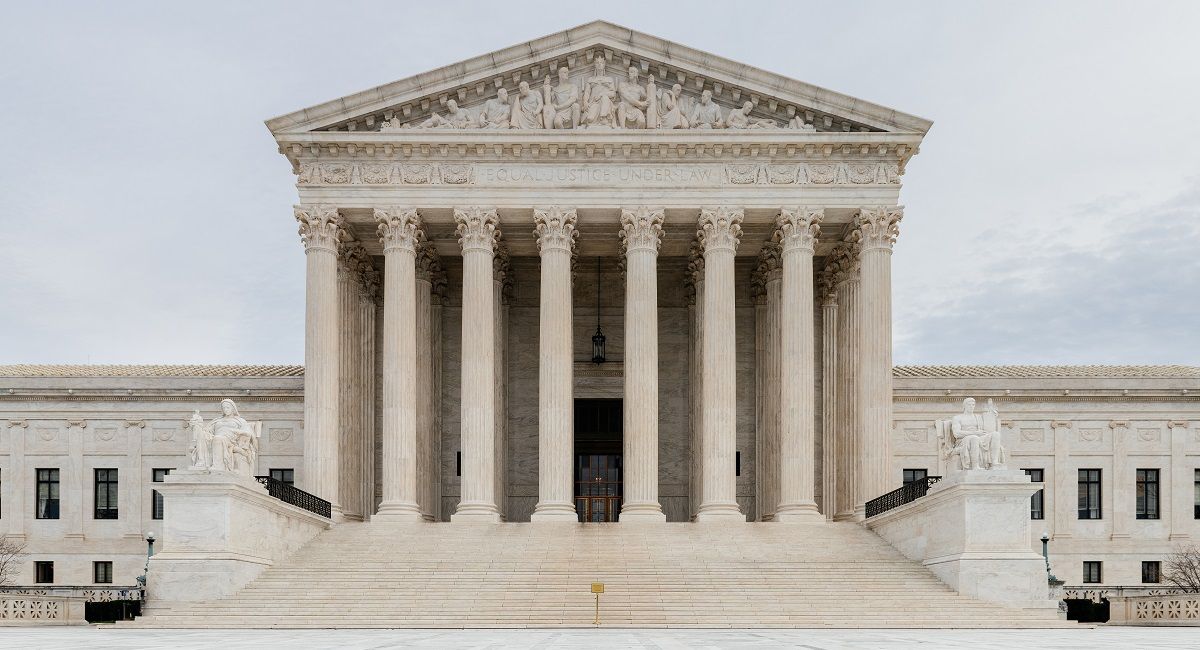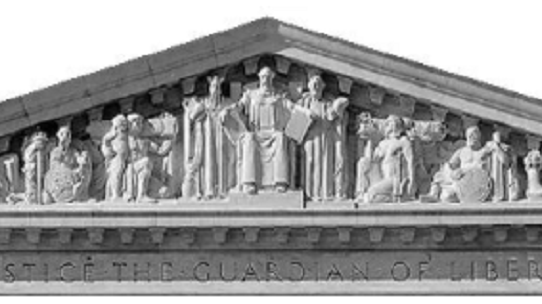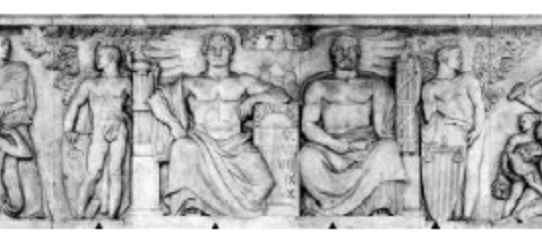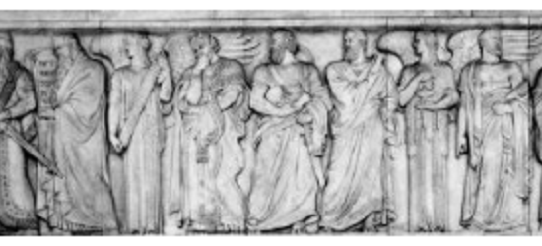Although the intent of this piece is to demonstrate a government endorsement of Judeo-Christian tradition through the symbols and words used in U.S. federal buildings and the writings of America's founding fathers, much of the information it presents is inaccurate.
Did you know ...
As you walk up the steps to the Capitol Building which houses the Supreme Court you can see near the top of the building a row of the world's law givers and each one is facing one in the middle who is facing forward with a full frontal view — it is Moses and the Ten Commandments!
As you enter the Supreme Court courtroom, the two huge oak doors have the Ten Commandments engraved on each lower portion of each door. As you sit inside the courtroom, you can see the wall right above where the Supreme Court judges sit a display of the Ten Commandments!
There are Bible verses etched in stone all over the Federal Buildings and Monuments in Washington, D.C.
James Madison, the fourth president, known as "The Father of Our Constitution" made the following statement "We have staked the whole of all our political institutions upon the capacity of mankind for self-government, upon the capacity of each and all of us to govern ourselves, to control ourselves, to sustain ourselves according to the Ten Commandments of God."
Patrick Henry, that patriot and Founding Father of our country said, "It cannot be emphasized too strongly or too often that this great nation was founded not by religionists but by Christians...not on religions but on the Gospel of Jesus Christ".
Every session of Congress begins with a prayer by a paid preacher...whose salary has been paid by the taxpayer since 1777.
Fifty-two of the 55 founders of the Constitution were members of the established orthodox churches in the colonies.
Thomas Jefferson worried about that the Courts would overstep their authority and instead of interpreting the law would begin making law...an oligarchy...the rule of few over many...
The very first Supreme Court Justice, John Jay, said, "Americans should select and prefer Christians as their rulers."
As you walk up the steps to the Capitol Building which houses the Supreme Court you can see near the top of the building a row of the world's law givers and each one is facing one in the middle who is facing forward with a full frontal view — it is Moses and the Ten Commandments!
- The United States Capitol does not house the Supreme Court of the United States. The Supreme Court has met in its own building since 1935.
-
The representations of Moses described above both present him in a context in which he is depicted as one of several historical exemplars of lawgivers, not as a religious figure. (This is why, for example, the Supreme Court of the United States in 2003 rejected appeals to overturn a decision ordering the removal of a monument to the Ten Commandments from an Alabama courthouse: they ruled that the monument did not present the Ten Commandments in a context other than as quotations of Biblical verse and was therefore deemed an unconstitutional state endorsement of religion.)
The depiction referred to here is a sculpture entitled "Justice the Guardian of Liberty" by Hermon A. McNeil, which appears on the eastern pediment of the Supreme Court building. (The eastern pediment is the back of the Supreme Court building, so this sculpture is not something one would see "walking up the steps to the building which houses the Supreme Court." The front entrance is on the western side.) The sculpture was intended to be a symbolic representation of three of the Eastern civilizations from which our laws were derived, personified by the figures of three great lawgivers: Moses, Confucius, and Solon (surrounded by several allegorical figures representing a variety of legal themes):
McNeil described the symbolism of his work thusly:Law as an element of civilization was normally and naturally derived or inherited in this country from former civilizations. The "Eastern Pediment" of the Supreme Court Building suggests therefore the treatment of such fundamental laws and precepts as are derived from the East. Moses, Confucius and Solon are chosen as representing three great civilizations and form the central group of this Pediment.
The two other lawgiver figures (Confucius and Solon) are not "facing [the] one in the middle" (i.e., Moses) as claimed above — all three of the lawgivers are depicted in full frontal views, facing forward. (The allegorical figures who flank the three lawgivers are indeed facing towards the middle, but they are looking in the direction of all three men, not just Moses.) The two tablets Moses holds in his arms are blank, without inscription.
As you enter the Supreme Court courtroom, the two huge oak doors have the Ten Commandments engraved on each lower portion of each door.
- The doors of the Supreme Court courtroom don't literally have the "Ten Commandments engraved on each lower portion." The lower portions of the two doors are engraved with a symbolic depiction, two tablets bearing the Roman numerals I through V and VI through X. As discussed in the next item, these symbols can represent something other than the Ten Commandments.1
As you sit inside the courtroom, you can see the wall right above where the Supreme Court judges sit a display of the Ten Commandments!
-
The wall "right above where the Supreme Court judges sit" is the east wall, on which is displayed a frieze designed by sculptor Adolph A. Weinman. The frieze features two male figures who represent the Majesty of Law and the Power of Government, flanked on the left side by a group of figures representing Wisdom, and on the right side by a group of figures representing Justice:
In a letter on file in the archives of the Supreme Court, Adolph Weinman, the designer of this frieze, states that the tablet visible between the two central male figures, engraved with the Roman numerals I through X, represents not the Ten Commandments but the first "ten amendments to the Constitution known as the 'Bill of Rights.'"2 -
The friezes which adorn the north and south walls of the courtroom in the Supreme Court building (also designed by Adolph Weinman) depict a procession of 18 great> lawgivers: Menes, Hammurabi, Moses, Solomon, Lycurgus, Solon, Draco, Confucius and Octavian (south wall); Justinian, Mohammed, Charlemagne, King John, Louis IX, Hugo Grotius, Sir William Blackstone, John Marshall and Napoleon (north wall):
According to the Office of the Curator of the Supreme Court of the United States, these figures were selected as a representation of secular law:Weinman's training emphasized a correlation between the sculptural subject and the function of the building and, because of this, [architect Cass] Gilbert relied on him to choose the subjects and figures that best reflected the function of the Supreme Court building. Faithful to classical sources, Weinman designed for the Courtroom friezes a procession of "great lawgivers of history," from many civilizations, to portray the development of secular law.
Moses is not given any special emphasis in this depiction: his figure is not larger than the others, nor does it appear in a dominant position. Also, the writing on the tablet carried by Moses in this frieze includes portions of commandments 6 through 10 (in Hebrew), specifically chosen because they are not inherently religious. (Commandments 6 through 10 proscribe murder, adultery, theft, perjury, and covetousness.)
James Madison, the fourth president, known as "The Father of Our Constitution" made the following statement "We have staked the whole of all our political institutions upon the capacity of mankind for self-government, upon the capacity of each and all of us to govern ourselves, to control ourselves, to sustain ourselves according to the Ten Commandments of God."
- This statement appears nowhere in the writings or recorded utterances of James Madison and is completely contradictory to his character as a strong proponent of the separation of church and state.
Patrick Henry, that patriot and Founding Father of our country said, "It cannot be emphasized too strongly or too often that this great nation was founded not by religionists but by Christians ... not on religions but on the Gospel of Jesus Christ".
-
Another spurious quotation. These words appear nowhere in the writings or recorded utterances of Patrick Henry.
They attached to Henry via an April 1956 article that appeared in The Virginian (reprinted in September 1956 in The American Mercury) in which a snippet from his will was followed by comments penned by the article's author. Those comments included the "founded by Christians" statement now mistakenly attributed to Henry.
Every session of Congress begins with a prayer by a paid preacher ... whose salary has been paid by the taxpayer since 1777.
-
Congress has indeed retained paid (Christian) chaplains since 1789 (not 1777) to open sessions with prayer and to provide spiritual guidance to members and their staffs upon request. That practice was strongly opposed by James Madison:
"The Constitution of the U.S. forbids everything like an establishment of a national religion," Madison wrote. "The law appointing Chaplains establishes a religious worship for the national representatives, to be performed by Ministers of religion, elected by a majority of them; and these are to be paid out of the national taxes. Does not this involve the principle of a national establishment, applicable to a provision for a religious worship for the Constituent as well as of the representative Body, approved by the majority, and conducted by Ministers of religion paid by the entire nation?"
Continued Madison, "[If] it be proper that public functionaries, as well as their Constituents should discharge their religious duties, let them like their Constituents, do so at their own expense."
Fifty-two of the 55 founders of the Constitution were members of the established orthodox churches in the colonies.
- The diverse beliefs and religiosity of America's founding fathers is a complex subject, one which cannot be so neatly encapsulated by an (inadequately substantiated) statement such as the one quoted above. (See, for example, this critique of the above-quoted statement and similar material.)
Thomas Jefferson worried about that the Courts would overstep their authority and instead of interpreting the law would begin making law ... an oligarchy ... the rule of few over many...
-
Yes, Thomas Jefferson was concerned about courts overstepping their authority and making (rather than interpreting) law, as was James Madison, who said: "As the courts are generally the last in making the decision, it results to them, by refusing or not refusing to execute a law, to stamp it with its final character. This makes the Judiciary department paramount in fact to the Legislature, which was never intended, and can never be proper."
However, this issue really has nothing to do with the subject at hand (the endorsement of Judeo-Christian tradition by the federal government), other than in the tangential sense that some people feel one of the areas in which U.S. courts have overstepped their bounds is the body of decisions prohibiting the use or display of religious symbols and references in state-operated institutions.
The very first Supreme Court Justice, John Jay, said, "Americans should select and prefer Christians as their rulers."
-
John Jay, one of the framers of the Constitution, was appointed by George Washington in 1789 to be the first Chief Justice of the Supreme Court of the United States (and later served two terms as governor of New York). He wrote, in a private letter (1816) to Pennsylvania House of Representatives member John Murray:
It certainly is very desirable that a pacific disposition should prevail among all nations. The most effectual way of producing it is by extending the prevalence and influence of the gospel. Real Christians will abstain from violating the rights of others, and therefore will not provoke war.
Providence has given to our people the choice of their rulers, and it is the duty as well as the privilege and interest of our Christian nation to select and prefer Christians for their rulers.
1 Some critics contend that anything that is tablet-shaped cannot possibly be interpreted as representing the U.S. Constitution, because that document "was not written on tablets." But one could use that same argument to contend that anything bearing the common version of Roman numerals cannot possibly represent the Ten Commandments, because that numbering system was not yet in use at the time of the events described in Exodus.
2 Although the authenticity of the Weinman letter has been challenged because it does not bear the hallmarks of his other business correspondence, there are several prosaic reasons that might explain the differences, such as that the item is a draft of a letter (which may or may not have been formally prepared and sent) or an archival copy of a piece of correspondence whose original has since been lost.




